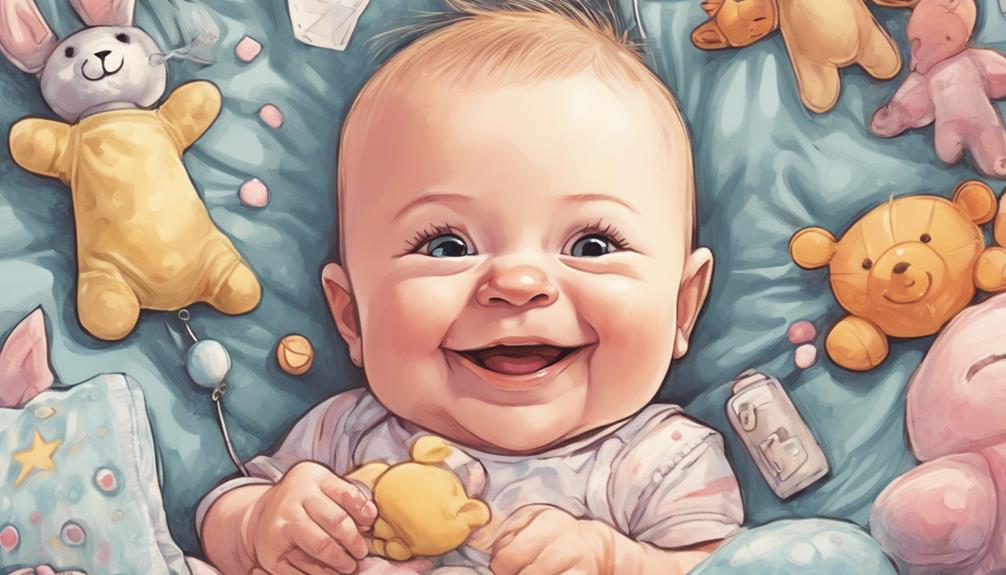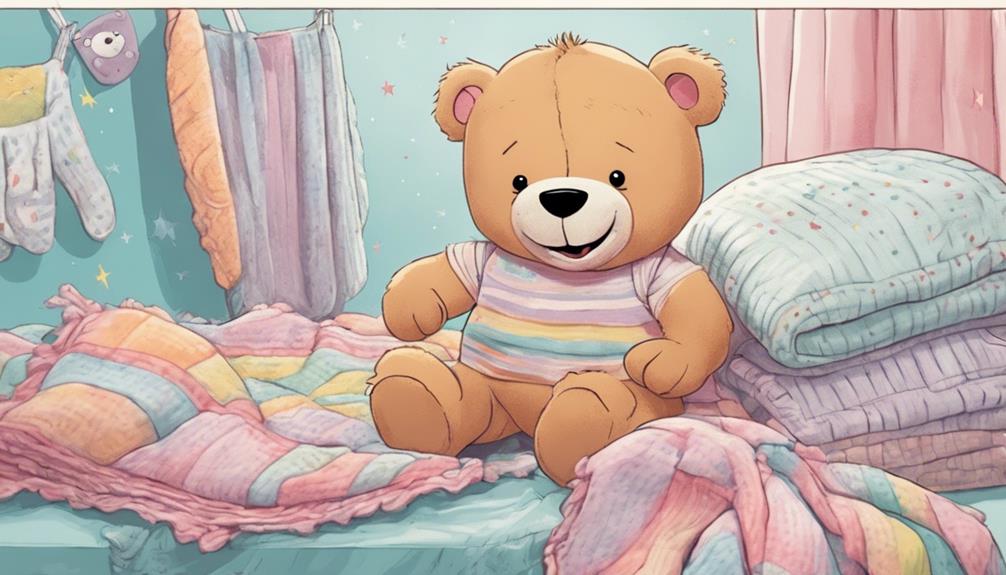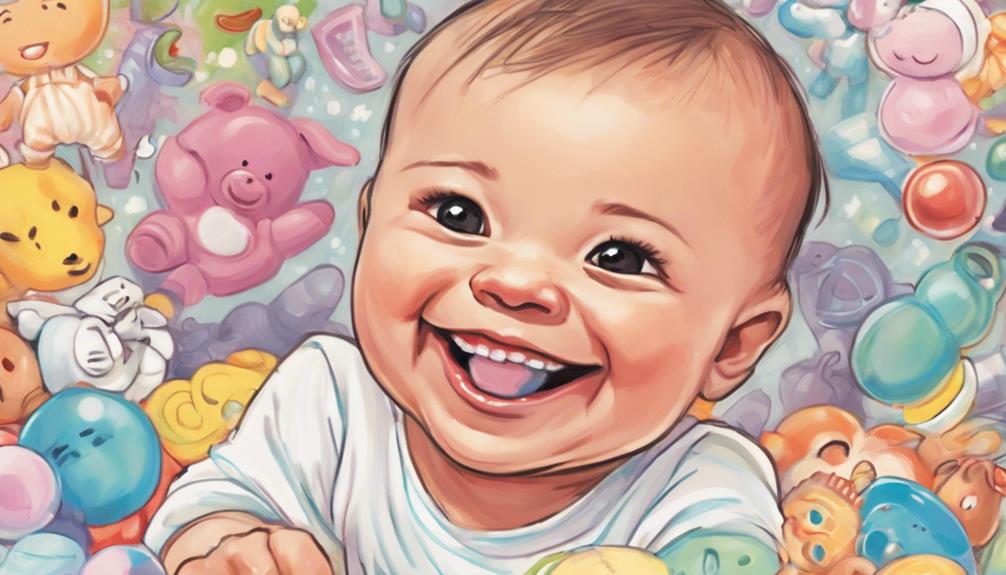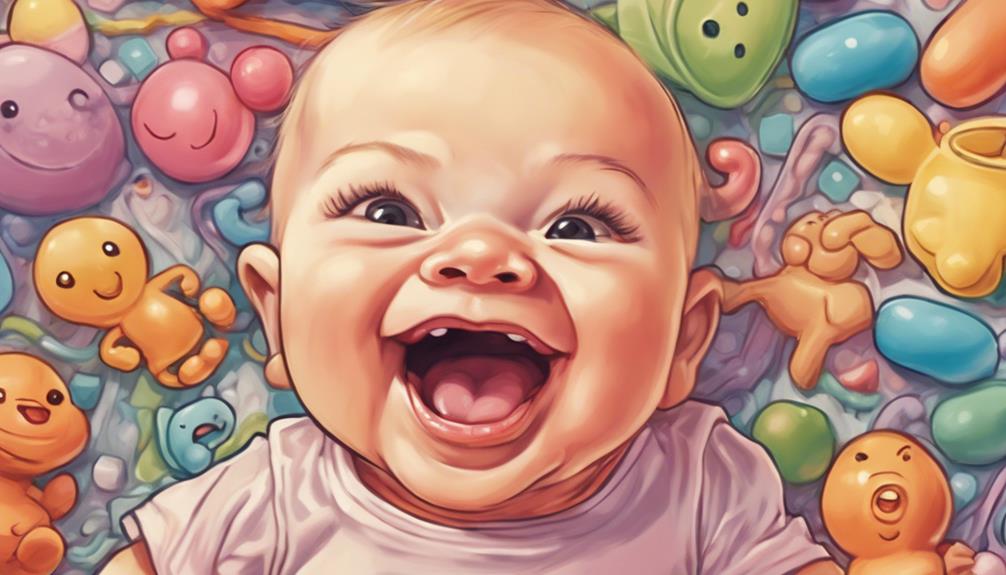You'll find that babies typically cut their first teeth when they're between 6 to 10 months old. The first teeth to appear are the lower central incisors. This can be an exciting and sometimes challenging time for both you and your little one. While some babies might show signs of discomfort, others sail right through without fuss. As your baby progresses, you'll notice the upper central incisors coming in next. It's a natural part of their development, and there's plenty more to discover about the teething process and what to expect along the way. As the baby teeth eruption order continues, you’ll see the lateral incisors, first molars, and canines make their debut. Keep in mind that every baby is different, so the sequence and timing of tooth eruption may vary. It’s important to provide your little one with teething toys or a clean, cool washcloth to help soothe their discomfort during this time. Remember to schedule their first dental visit around their first birthday to ensure their teeth and gums are healthy and developing properly.
Key Takeaways
- The first teeth to emerge in babies are typically the lower central incisors, appearing between 6 to 10 months.
- Following the lower central incisors, the upper central incisors usually erupt between 8 to 12 months.
- After the central incisors, upper lateral incisors generally appear between 9 to 11 months.
- Lower lateral incisors typically emerge around 10 to 12 months after the upper lateral incisors.
Understanding Teething
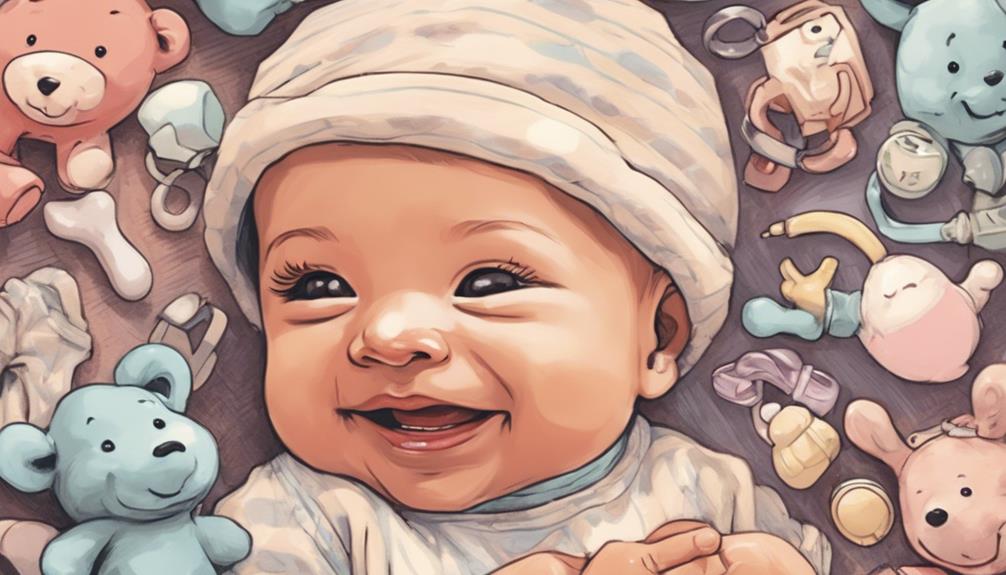
Teething is an important milestone in your baby's development, usually starting between 4 to 7 months when those first little teeth begin to break through the gums. The first teeth to emerge are typically the lower central incisors, which can cause some teething pain as they force their way through. This process can vary from one child to another; while some babies may not show discomfort, others might be fussy and experience swollen gums.
As your baby grows, you'll notice the appearance of more baby teeth, usually following the lower incisors with the upper front teeth about 4 to 8 weeks later. By age 3, your child will have a complete set of 20 primary teeth. These teeth not only aid in chewing but also play a crucial role in speech development and overall dental health.
It's essential to monitor your baby's oral health during this period. Make sure to schedule their first dental appointment around their first tooth's arrival, setting the foundation for good oral habits that will benefit them in the long run. Understanding teething helps you support your child through this natural process.
Typical Teething Timeline
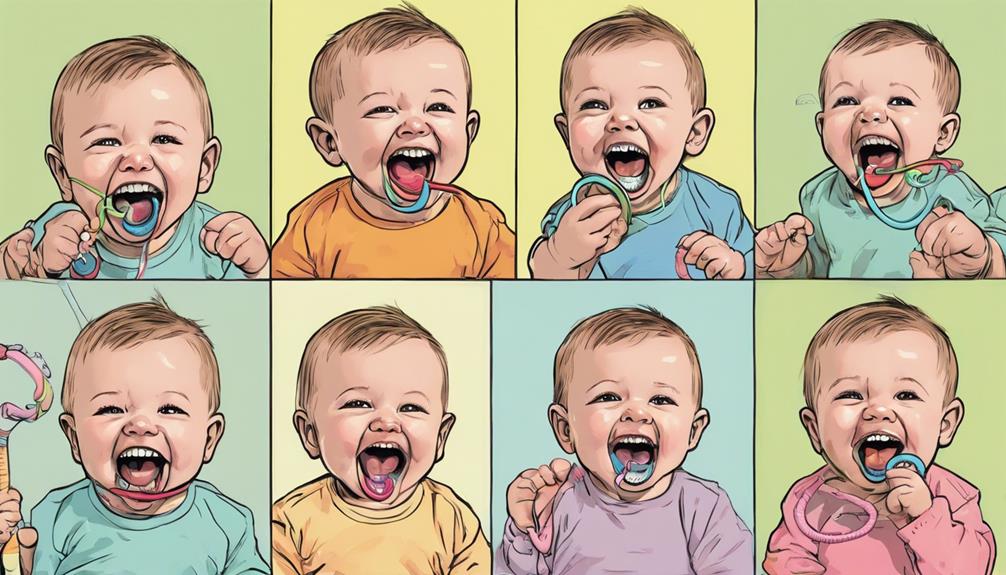
Understanding the typical teething timeline can help you anticipate when your baby's first teeth will emerge and what to expect during this exciting phase. Babies usually begin teething between 4 to 7 months of age, with the lower central incisors being the first to appear. Here's a quick overview of the teething timeline:
| Teeth Type | Months of Age |
|---|---|
| Lower Central Incisors | 6 to 10 months |
| Upper Central Incisors | 8 to 12 months |
| Lateral Incisors | 9 to 16 months |
| First Molars | 13 to 19 months (upper), 14 to 18 months (lower) |
As your baby grows, you can expect the upper central incisors to emerge next, followed by the lateral incisors. The upper lateral incisors typically arrive between 9 to 13 months, while the lower lateral incisors follow between 10 to 16 months. First molars generally appear last, completing the process of teething. By the age of 3, most children have all 20 primary teeth, wrapping up the typical teething timeline.
Signs of Teething
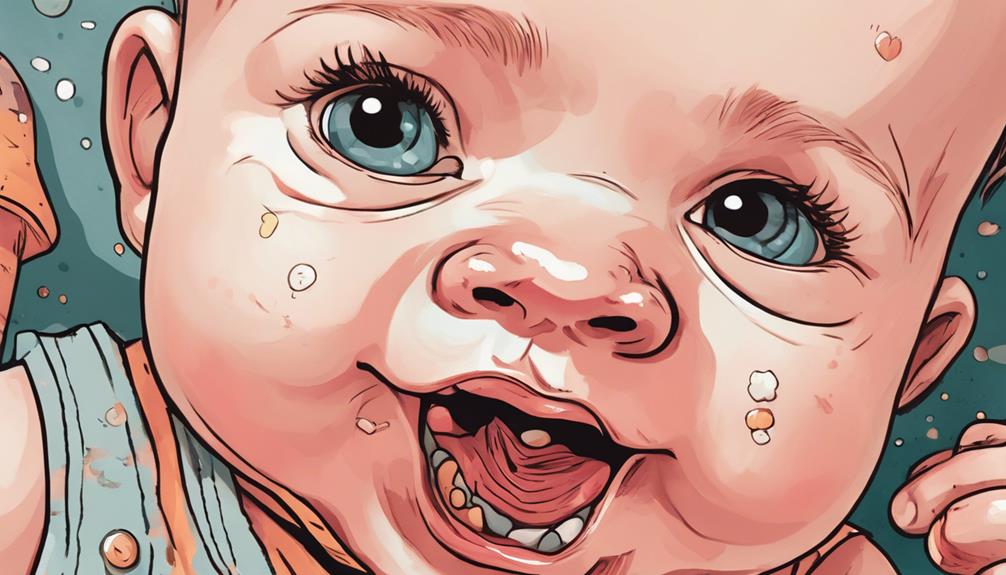
Watch for increased drooling, irritability, and a strong urge to chew on objects as your baby starts showing signs of teething. The first teeth to come, typically the lower central incisors, emerge between 6 to 10 months of age. During this period, you may notice your little one experiencing sore gums and swollen gums, making it uncomfortable for them.
Irritability is another common sign of teething. As babies start teething, they might become fussy and more difficult to soothe. You could also observe a slight temperature rise, but if it exceeds 102°F, it's important to consult a pediatrician, as this may indicate an illness rather than simply teething.
To help alleviate some discomfort, consider providing your baby with teething rings. These can be soothing for sore gums and can distract them from the discomfort associated with teething.
Remember that while increased drooling, irritability, and the urge to chew are usual signs of teething, it's vital to distinguish these symptoms from other potential health issues. Keeping an eye on these signs will help you support your baby during this challenging time.
Order of Tooth Eruption

The order in which your baby's teeth erupt follows a predictable pattern that typically starts with the lower central incisors around 6 to 10 months.
After those first teeth start coming in, you can expect the upper central incisors to follow between 8 and 12 months. Next, the upper lateral incisors usually emerge between 9 and 11 months, while the lower lateral incisors appear around 10 to 12 months.
As your child continues to grow, the first molars will make their appearance. For the upper first molars, this typically happens between 13 and 19 months, and for the lower first molars, expect them between 14 and 18 months.
By the time your child reaches age 3, most will have all 20 primary teeth, completing the tooth eruption process.
Understanding this order can help you anticipate your baby's teething phases and provide relief during uncomfortable moments. Keeping track of which teeth have emerged can also help you monitor your child's dental development, ensuring that their smile is on the right path as they grow.
Caring for Baby's Teeth
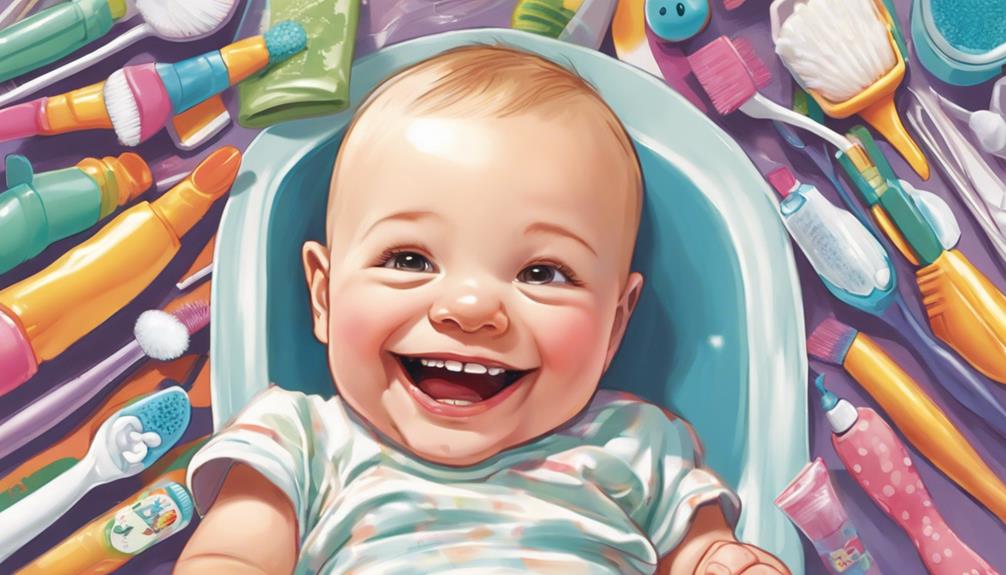
Caring for your baby's teeth starts before the first tooth appears, laying the groundwork for a lifetime of good oral hygiene.
Even before that first tooth erupts, gently clean your baby's gums with a soft cloth to establish healthy habits.
Once baby teeth appear, use a soft-bristled toothbrush and a smear of fluoride toothpaste to brush twice daily. This helps prevent tooth decay, which can be a concern as your little one grows.
It's also important to schedule your baby's first dental visit by age one or as soon as their first tooth emerges. This allows a pediatric dentist to monitor dental health and development, addressing any concerns early on.
Be mindful of teething discomfort, and regularly check for signs of dental issues. If you notice anything unusual, consult your pediatric dentist for personalized advice.
Additionally, avoid putting your baby to bed with a bottle, as milk can pool in the mouth, promoting cavities and tooth decay.
Frequently Asked Questions
In What Order Do Babies Cut Their Teeth?
When babies cut their teeth, they typically start with the lower central incisors, followed by the upper central incisors, upper lateral incisors, lower lateral incisors, and then the molars and canines as they grow.
Which Teeth Are Most Painful for Babies?
Like a storm brewing, teething pain can hit hard. You'll find that your baby often struggles most with molars and incisors, as their larger size and pressure cause significant discomfort during the eruption process.
Which Teeth Should Come First in Babies?
When you think about which teeth should come first in babies, the lower central incisors usually emerge between 6 to 10 months. Following them, the upper central incisors typically appear around 8 to 12 months.
Does Teething Pain Stop Once Tooth Cuts?
Teething pain's a rollercoaster; it often subsides once the tooth breaks through. However, your child might still feel discomfort as more teeth emerge. Keep an eye out for any unusual symptoms afterward.
Are the First Teeth Babies Get also the First Teeth they Cut?
Yes, the first teeth babies get are also the first teeth they cut in their babies’ first teeth development. These primary teeth, also known as deciduous teeth, typically start to emerge between the ages of 6 and 10 months. It is an exciting milestone in a baby’s development and an important step in their oral health journey.
How Does the Root of Baby Teeth Affect the Teething Process?
During the teething process, the root of baby teeth plays a crucial role in providing support and stability for the emerging teeth. This is why baby teeth have roots. The roots help the baby teeth to anchor securely in the jaw, allowing for proper development and positioning of the permanent teeth.
Conclusion
In the grand adventure of teething, your baby's first tooth is like a tiny knight emerging triumphantly from the castle of gums!
You might feel like a proud parent at a royal ceremony as that little pearly white makes its debut.
Remember, every tooth that follows is a new champion ready to conquer mealtime and giggles alike.
So, embrace this wild ride and care for those precious teeth, because they're the keys to revealing a world of yummy treats and bright smiles!
